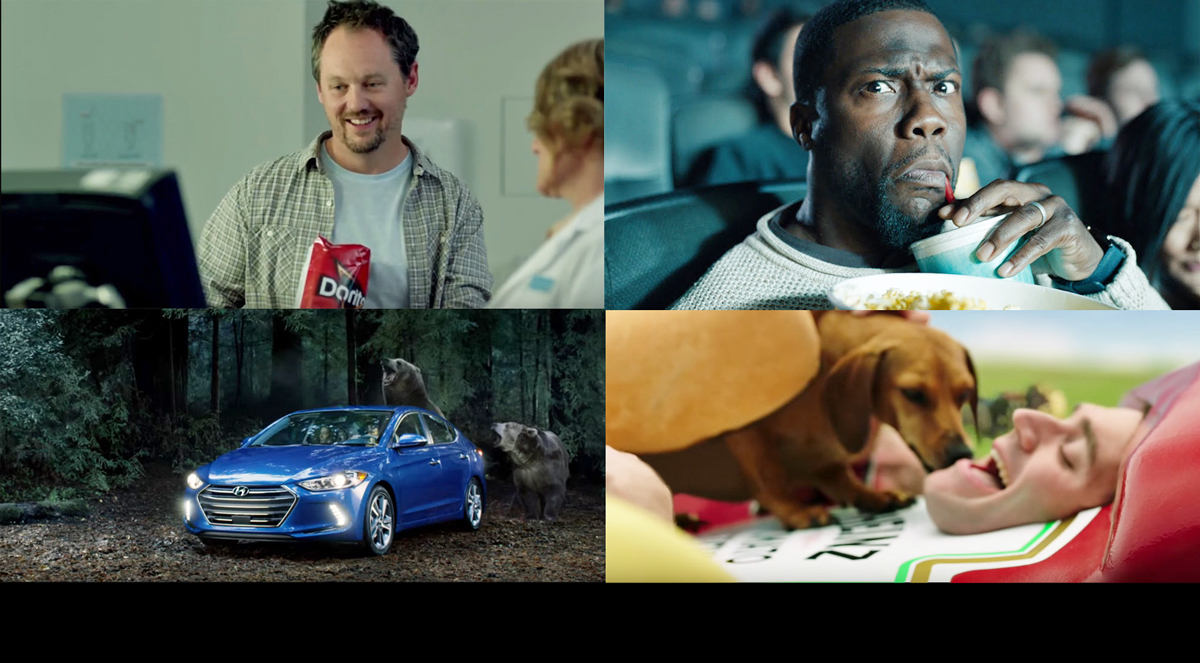For years, Doritos has stuck with a Super Bowl campaign strategy of asking consumers to submit videos to potentially air during the big game. It’s a strategy that doesn’t necessarily result in the most memorable or highest quality ads, but nets decent pre-game publicity, as well as millions of YouTube views. Experts agree it’s also a tactic that asks a lot of consumers, so it’s not likely one that will work for most brands. At the same time, however, user-generated content offers advantages like authenticity, discovery, and illuminating how consumers perceive the brand. One more accessible alternative to consider is influencer partnerships, which allow brands to harness consumer-generated content from passionate users in a much more explicit value exchange.
Earlier this month, Doritos announced the finalists in yet another round of its Crash the Super Bowl contest, offering Super Bowl airtime, a $1 million grand prize and a “dream job” at Universal Pictures to the winner.
The brand reportedly received nearly 4,900 submissions from 29 countries this year. As in prior years, fans are invited to vote for their favorites on the Doritos website until January 28. Two of the videos will air during Super Bowl XLIX one selected by fans and the other by the brand itself.
The contest dates back to 2006. In a prepared statement, Ram Krishnan, senior vice president and chief marketing officer of Frito-Lay North America, nods to the contest’s longevity, saying, “Doritos fans are among the most talented and creative individuals out there — they’ve blown us away each year for nearly a decade.”
It’s certainly become something of an annual event and, if nothing else, has generated millions of views.
The 2014 winner, Time Machine, for example, netted about 2.5 million views.
And, another 2014 finalist, Finger Cleaner, has 4.2 million.
So with nearly a decade of Super Bowl crashing under its belt, what lessons does Crash the Super Bowl offer other brands? Particularly when it comes to harnessing user-generated content?
Own Your Territory
“Basically, the reason I feel it is still ongoing is that they are the only people doing it and I think it’s as ownable a territory as happiness for Coke and making people cry with animals for Budweiser,” said Jess Greenwood, vice president of content and partnerships at advertising agency R/GA.
Doritos launched Crash the Super Bowl when user-generated content was a big buzzword and “every other brand leapt on it,” Greenwood said. But, since then, “Doritos doubled down and is literally the last man standing.”
That’s not to say the contest hasn’t morphed over time. The brand now offers prize money and has opened up submissions to an international audience, which Greenwood said is an interesting tactic given increased interest in the Super Bowl overseas.
Doritos does a great job of perpetuating the hype cycle at the “one moment when everyone and [their] grandmother gives a damn about what’s happening in the ad industry,” Greenwood said. “There’s definitely a correlation between the moment itself and the way they’ve chosen to create enthusiasm, which is very smart.”
While the prize money certainly doesn’t hurt, Apu Gupta, CEO of visual marketing platform Curalate, points to the opportunity to be seen on one of the world’s biggest stages as another motivating factor for fan participation.
“To me, it’s the same reason that even against all odds, people continue to play the lottery,” he said. “But the payoff in this case is recognition.”
Make Your Content Memorable, Relevant
Doritos’ Crash the Super Bowl effort isn’t flawless.
While the contest certainly generates headlines each year, Greenwood said, “I do also feel this is one of those advertising mechanisms in which the mechanism is way more interesting than the content it is producing.”
In other words, she said it has not resulted in many notable commercials over the years while other brands have instead invested in work with agencies to produce culturally relevant and more memorable spots like Coke’s America is Beautiful ad last year, which has 12.2 million views to date.
“I think what Doritos is trying to do is keep the mechanism alive as long as possible, but it does have the unfortunate effect that the content is not standing up against other Super Bowl ad content,” Greenwood said. “I wonder how much longer it will run. But I wondered that in 2008.”
Give Your Fans A ‘Social High Five’
But that’s not to say user-generated content isn’t a powerful brand asset.
Per Gupta, outside of the Doritos example because it requires so much work on behalf of participants, consumer-generated content “has a level of authenticity that brand-generated content does not.”
In general, user-generated content allows brands to recognize fans at scale like a “social high five,” Gupta said. “When you tweet out something and some brand likes your photo or likes your tweet, it’s, ‘Ohmygosh.’ There’s a little part of you that feels incredibly validated.”
User-Generated Content Builds Brand Awareness
Consumers trust their peers more than brands, which means user-generated content can be more identifiable and inspirational to consumers, Gupta said. “Essentially, user-generated content aids in discovery,” Gupta added.
He pointed to a gallery on the website of retailer Urban Outfitters with curated images including the hashtag #UOonYou.
“Every day, people visit Urban Outfitter’s website and find themselves directed to this page to check out real people celebrating their love for Urban Outfitters. These photos are beautiful and lend themselves to browsing and exploring. These images are inspirational – they provide people ideas of how real products look in the real world. It’s street style, captured,” Gupta said. “And since these images are linked to products, it’s incredibly easy to go from inspiration to purchase. This entire experience is predicated upon browsing and discovery – there’s no product search here – and consumers love it.”
Train Your Customers With User-Generated Content
Brands can use consumer-generated content to more or less train their customers to produce the kind of content they want.
“Urban Outfitters gets to select which photos get featured [on its social channels] and if, over time, a particular aesthetic style [is more predominant, consumers learn that] if they want to get featured, [they need to emulate it],” he said.
Gupta said the situation with Doritos is similar. The Crash the Super Bowl videos share themes like quirkiness and youthfulness as if “someone curated the videos and said, ‘This is what we stand for.’”
Tell People What’s In It For Them
In addition, Gupta said the user-generated consumer landscape has become much more consumer direct over time in which brands encourage fans to get involved and that is in part due to tools like GoPro, which come at an accessible price point and allow consumers to create high-quality videos.
“When you put a ton of tools in the hands of tons of people and put that against the backdrop of recognition in a massive way and [offer] prize money, too, it really does create the right incentive to try out,” Gupta said.
Greenwood said this pure-play user-generated content strategy from Doritos relies on a large time investment from consumers, it’s hard for many brands to justify that because consumers are busy.
“People have a lot of other stuff to do other than make content for brands. This is why Doritos now pays a lot of money to the winning entry, where they didn’t have to in the beginning,” Greenwood said. “If you, as a brand, are expecting quality content, the value exchange has to be very explicit. Otherwise, what’s in it for them?”
Partner With Influencers
The definition of a “user” has changed over time, said Greenwood.
“In 2005, when everyone was terribly excited by the idea that normal people were creating videos and uploading them to the Internet, a ‘user’ was anyone with a camera who was prepared to have a go. Now, content is the most abundant resource on the Internet, and standing out is difficult. It’s therefore unrealistic to think that all marketers could get the average Joe to create stuff for them, for free, and expect it to perform well,” Greenwood said. “Instead, we look to influencers: people with a proven level of expertise and their own built-in audiences, which makes their content effective.”
One option for brands is to partner with influencers who are already creating content around their passion points, which allows brands to reap some of the benefits of user-generated content without requiring either a huge time commitment from consumers, or a $1 million grand prize.
Motivate Your Customers
Gupta said brands should also make sure consumers know they are looking for content from users that they are willing to feature.
“A lot of brands have a lot of touchpoints and they need to use those touchpoints to make it clear to consumers – to essentially ask for content,” Gupta said. “We’re increasingly starting to see on a receipt or packaging, a hashtag [or messaging about taking a selfie] and [brands] may be surprised, but a simple ask actually builds a lot of awareness and motivates [consumers] to participate.”
In addition, Gupta said brands can use user-generated content in much broader ways, including determining how consumers perceive them.
“If you’re Doritos, how much you dislike or like the video can help you start to better understand how consumers perceive you,” Gupta said. “Think about red Solo cups. A red Solo cup is used in a lot of different ways, but if you look it up for user-generated content, it is almost invariably associated with parties, for flip cup and beer pong and fraternity stuff. Whether you want your brand to stand for that is beside the point. But you can learn a lot about how people perceive you based upon how they use your product in photos [and videos].”
Follow The Trends
Videos of people getting injured or with slapstick comedy certainly make rounds on YouTube, but Greenwood said a general lesson for brands is in looking at what the culture currency of the Internet is at any given time.
“A huge trend last year was creating big, emotional films and video pieces that make you cry, which is directly correlated to the way content is shared on the Internet,” she said. “Doritos has owned slapstick…every other brand should look at what that cultural currency is as far as its own brand is concerned and how to translate that.”
And while time will tell which of this year’s spots will come out on top, Greenwood notes, “Five of the finalists have adorable moppety children in them, which is a huge change from previous years where the comedy’s been of a more bro-like nature.”
In addition, she said it will be interesting if the winning ad this year is less slapstick.
“Will it be really emotional? Will it have a surprise twist ending? These are the things we see every day as trends on the Internet that we can identify very clearly. It might be completely off-brand, but it’s possible that users could create content that addresses the tropes very clearly and it turns out to be the best of the lot,” Greenwood said. “And people vote on the winners – it’s up to us – so it will be really interesting to see if it will sneak through or if it will be a vending machine landing on someone again. If the content evolves, it could get fascinating.”
Make User-Generated Campaigns Evergreen
Finally, Gupta also cautions to make sure user-generated campaigns are evergreen.
“A lot of Doritos are consumed during the Super Bowl, but also throughout the year,” Gupta said. “So feature and solicit user-generated content throughout the year. It’s about celebrating consumers, not just one time of year.”
What lessons do you see in Doritos’ annual Super Bowl effort?


